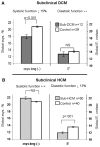Subtle abnormalities in contractile function are an early manifestation of sarcomere mutations in dilated cardiomyopathy
- PMID: 22949430
- PMCID: PMC3646896
- DOI: 10.1161/CIRCGENETICS.112.962761
Subtle abnormalities in contractile function are an early manifestation of sarcomere mutations in dilated cardiomyopathy
Abstract
Background: Sarcomere mutations cause both dilated cardiomyopathy (DCM) and hypertrophic cardiomyopathy (HCM); however, the steps leading from mutation to disease are not well described. By studying mutation carriers before a clinical diagnosis develops, we characterize the early manifestations of sarcomere mutations in DCM and investigate how these manifestations differ from sarcomere mutations associated with HCM.
Methods and results: Sixty-two genotyped individuals in families with sarcomeric DCM underwent clinical evaluation including strain echocardiography. The group included 12 subclinical DCM mutation carriers with normal cardiac dimensions and left ventricular ejection fraction (LVEF ≥55%), 21 overt DCM subjects, and 29 related mutation (-) normal controls. Results were compared with a previously characterized cohort of 60 subclinical HCM subjects (sarcomere mutation carriers without left ventricular hypertrophy). Systolic myocardial tissue velocity, longitudinal, circumferential, and radial strain, and longitudinal and radial strain rate were reduced by 10%-23% in subclinical DCM mutation carriers compared with controls (P<0.001 for all comparisons), after adjusting for age and family relations. No significant differences in diastolic parameters were identified comparing the subclinical and control cohorts. The opposite pattern of contractile abnormalities with reduced diastolic but preserved systolic function was seen in subclinical HCM.
Conclusions: Subtle abnormalities in systolic function are present in subclinical DCM mutation carriers, despite normal left ventricular size and ejection fraction. In contrast, impaired relaxation and preserved systolic function appear to be the predominant early manifestations of sarcomere mutations that lead to HCM. These findings support the theory that the mutation's intrinsic impact on sarcomere function influences whether a dilated or hypertrophic phenotype develops.
Figures


Comment in
-
It's never too early to look: subclinical disease in sarcomeric dilated cardiomyopathy.Circ Cardiovasc Genet. 2012 Oct 1;5(5):483-6. doi: 10.1161/CIRCGENETICS.112.964817. Circ Cardiovasc Genet. 2012. PMID: 23074334 Free PMC article. No abstract available.
References
-
- Boucek MM, Aurora P, Edwards LB, Taylor DO, Trulock EP, Christie J, et al. Registry of the International Society for Heart and Lung Transplantation: tenth official pediatric heart transplantation report–2007. J Heart Lung Transplant. 2007;26:796–807. - PubMed
-
- Mahon NG, Murphy RT, MacRae CA, Caforio AL, Elliott PM, McKenna WJ. Echocardiographic evaluation in asymptomatic relatives of patients with dilated cardiomyopathy reveals preclinical disease. Ann Intern Med. 2005;143:108–115. - PubMed
Publication types
MeSH terms
Grants and funding
LinkOut - more resources
Full Text Sources

